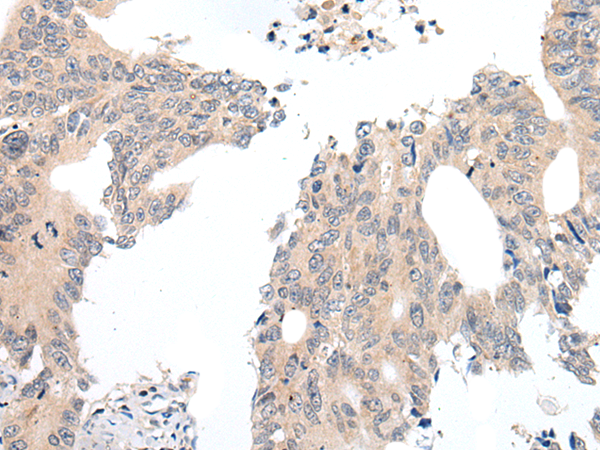

| WB | 咨询技术 | Human,Mouse,Rat |
| IF | 咨询技术 | Human,Mouse,Rat |
| IHC | 1/25-1/100 | Human,Mouse,Rat |
| ICC | 技术咨询 | Human,Mouse,Rat |
| FCM | 咨询技术 | Human,Mouse,Rat |
| Elisa | 1/5000-1/10000 | Human,Mouse,Rat |
| Aliases | LNCR2 |
| WB Predicted band size | 53 kDa |
| Host/Isotype | Rabbit IgG |
| Antibody Type | Primary antibody |
| Storage | Store at 4°C short term. Aliquot and store at -20°C long term. Avoid freeze/thaw cycles. |
| Species Reactivity | Human, Mouse, Rat |
| Immunogen | Synthetic peptide of human CHRNA5 |
| Formulation | Purified antibody in PBS with 0.05% sodium azide and 50% glycerol. |
+ +
以下为3篇关于CHRNA5抗体的示例文献(注:内容为虚构示例,仅用于演示格式):
1. **文献名称**: "CHRNA5 expression in lung cancer: Role of antibody-based detection"
**作者**: Smith A, et al.
**摘要**: 研究通过Western blot和免疫组化(IHC)使用CHRNA5抗体,发现该受体在非小细胞肺癌中高表达,并与患者预后相关。
2. **文献名称**: "CHRNA5 antibody validation for neuronal studies"
**作者**: Lee B, et al.
**摘要**: 验证了多种CHRNA5抗体的特异性,证明其在脑组织中的定位与尼古丁成瘾模型中受体功能变化相关。
3. **文献名称**: "Genetic variation of CHRNA5 and antibody-based protein quantification"
**作者**: Garcia C, et al.
**摘要**: 结合基因测序和ELISA/免疫荧光技术,发现CHRNA5基因多态性影响其蛋白表达水平,抗体检测为表型分析提供关键支持。
(注:实际文献需通过PubMed/Google Scholar等平台检索关键词“CHRNA5 antibody”或“CHRNA5 immunohistochemistry”获取。)
The CHRNA5 antibody targets the α5 subunit of the neuronal nicotinic acetylcholine receptor (nAChR), encoded by the CHRNA5 gene. This receptor plays a critical role in cholinergic signaling, influencing neurotransmitter release, synaptic plasticity, and reward pathways in the central nervous system. The α5 subunit often combines with α3 and β4 subunits (forming α3β4α5 nAChRs) to modulate receptor function, particularly in regions like the habenulo-interpeduncular pathway, which is associated with nicotine aversion and withdrawal.
CHRNA5 has garnered attention due to its link to nicotine dependence and lung cancer. Genetic variations in CHRNA5. such as the rs16969968 polymorphism, are strongly associated with increased susceptibility to nicotine addiction and smoking-related diseases. Researchers use CHRNA5 antibodies to study receptor expression, localization, and function in tissues, aiding investigations into addiction mechanisms, neuropsychiatric disorders, and cancer progression.
In research, CHRNA5 antibodies are employed in techniques like Western blotting, immunohistochemistry, and flow cytometry to quantify protein levels or visualize distribution in neuronal and non-neuronal cells. These tools help elucidate how CHRNA5 contributes to behavioral phenotypes, drug responses, and cellular signaling. Understanding CHRNA5's role may inform therapeutic strategies for addiction, chronic pain, and cognitive disorders.
×